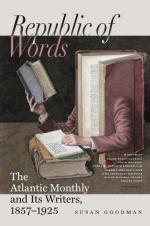One book of great beauty would hardly raise our faith so far. It might be the result of a fortunate combination of propitious circumstances, an accident of which the best intent in the world could not cause a deliberate repetition,—for chance can work well as easily as ill, may make a plan as simply as mar it, and none need be told how often the best-devised schemes “gang a-gley” by reason of some fortuity for which no allowance had been made.
But when from the same press there emanate in a single season several books, prepared at different times by different hands, although, of course, under the same general direction and supervision, the natural inference is, that something positive has been attained, either in the principle of manufacture, or in a better understanding of the elements which must enter into the composition of a really elegant book, and a juster estimate of the manner in which these elements are to be combined.
In the four books under consideration, all the necessary conditions appear to have been recognized and fulfilled. It is, of course, too much to say that they are perfect, and many who are versed in the particulars of lineal art will perhaps find things which they might wish otherwise. But with all such qualification, these volumes show indisputably that in the matter of illustration and typography the New World is now quite the equal of the Old.
The artists engaged—to whose names, as mentioned above, should be added those of H. Fenn, G. Perkins, S. Colman, Jr., and W. Waud, as illustrators of “Flower-de-Luce”—are all men well known, and most of them are eminent in their profession. Each has had a subject which suited closely his capacity and taste, together, evidently, with the liberty of treating his theme according to his own discretion, and as amply as he pleased,—the brief poem, “Maud Muller,” for instance, having been supplied by Mr. Hennessy with thirteen illustrations, while in the other volumes equal liberality is manifest.
We have not the space to make, as we should like to do, an exact analysis of these volumes, comparing each artist’s series of drawings, one by one, with his chosen passages of the text; but a careful examination convinces us that as a whole these designs are remarkably appreciative and apt. Every person will not expect his own ideal Evangeline or Sir Launfal to appear before him on the page, but every reflective mind will find, we think, such a parallelism between poetry and picture as is not only consistent with exactness, but will further serve to illuminate and beautify the text.
Intelligent or even inspired drawing is vain, if to it be not added faithfulness and fervor on the part of those whose handiwork follows that of the draughtsman, and upon whom his fate and fame greatly depend,—the engraver and the printer. Heretofore it has seemed almost impossible for American representatives of these three arts to work together for good. The drawing might be faultless as it lay intact upon the wood, but the graver in a heedless hand or the manipulation of an injudicious pressman left little except the broad, indestructible characteristics in the impression which was eventually made public.




